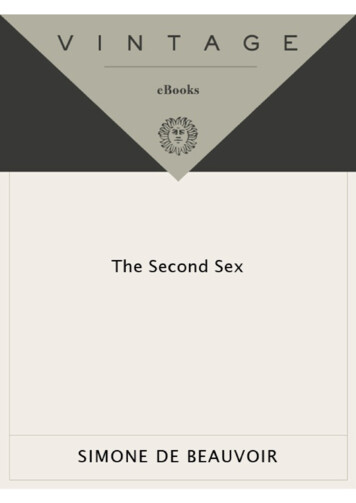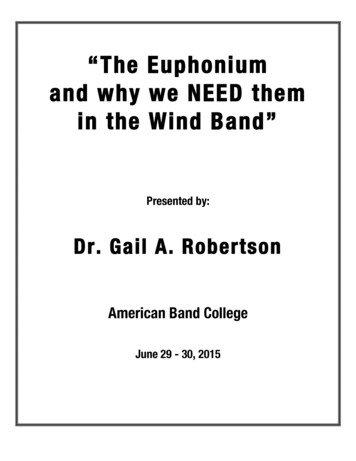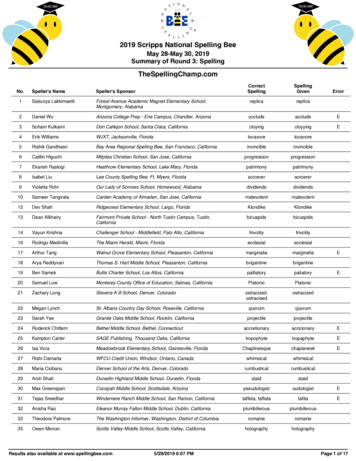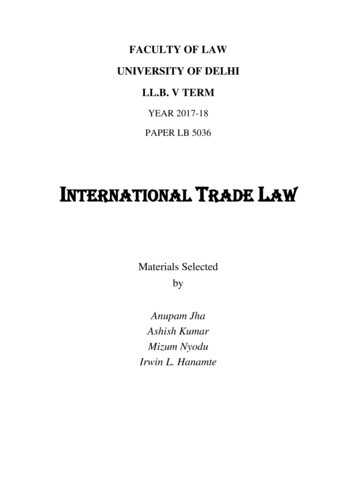
Transcription
SIMONE DE BEAUVOIRThe Second SexSimone de Beauvoir was born in Paris in 1908. In 1929 she becamethe youngest person ever to obtain the agrégation in philosophy at theSorbonne, placing second to Jean-Paul Sartre. She taught in lycées inMarseille and Rouen from 1931 to 1937, and in Paris from 1938 to1943. After the war, she emerged as one of the leaders of theexistentialist movement, working with Sartre on Les TempsModernes. The author of many books, including the novel TheMandarins (1957), which was awarded the Prix Goncourt, Beauvoirwas one of the most influential thinkers of her generation. She died in1986.Constance Borde and Sheila Malovany-Chevallier have lived in Parisfor more than forty years and are both graduates of RutgersUniversity, New Jersey. Borde and Malovany-Chevallier were facultymembers at the Institut d’Études Politiques. They have beentranslating books and articles on social science, art, and feministliterature for many years and have jointly authored numerous books inEnglish and in French on subjects ranging from grammar to politics toAmerican cooking.2
3
FIRST VINTAGE BOOKS EDITION, MAY 2011Le deuxième sexe copyright 1949 by Éditions Gallimard, ParisTranslation copyright 2009 by Constance Borde and Sheila Malovany-ChevallierIntroduction copyright 2010 by Judith ThurmanAll rights reserved. Published in the United States by Vintage Books, a division ofRandom House, Inc., New York, and in Canada by Random House of Canada Limited,Toronto. Originally published in France in two volumes as Le deuxième sexe: Les faitset les mythes (Vol. 1) and L’expérience vécue (Vol. 11) by Éditions Gallimard, Paris.Copyright 1949 by Éditions Gallimard, Paris. This translation originally publishedin hardcover in slightly different form in Great Britain by Jonathan Cape, The RandomHouse Group Ltd., London, in 2009, and subsequently published in hardcover in theUnited States by Alfred A. Knopf, a division of Random House, Inc., New York, in2010.Vintage and colophon are registered trademarks of Random House, Inc.The Library of Congress has cataloged the Knopf edition as follows:Beauvoir, Simone de, 1908–1986.[Deuxième sexe. English]The second sex / Simone de Beauvoir ; translated by Constance Borde andSheila Malovany Chevallier.p. cm.1. Women. I. Borde, Constance. II. Malovany-Chevallier, Sheila. III. Title.HQ1208.B352 2010305.401—dc222009023164eISBN: 978-0-307-81453-1www.vintagebooks.comv3.14
To Jacques BostThere is a good principle that createdorder, light, and manand a bad principle that createdchaos, darkness, and woman.— PYTHAGORASEverything that has been written by menabout women should be viewed with suspicion,because they are both judge and party.—POULAIN DE LA BARRE5
ContentsCoverAbout the AuthorTitle PageCopyrightDedicationIntroduction by Judith ThurmanTranslators’ NoteVOLUME IFacts and MythsIntroductionPART ONE DESTINYChapter 1 Biological DataChapter 2 The Psychoanalytical Point of ViewChapter 3 The Point of View of Historical MaterialismPART TWO HISTORYChapter 1Chapter 2Chapter 3Chapter 4Chapter 5PART THREE MYTHSChapter 1Chapter 2I. Montherlant or the Bread of DisgustII. D. H. Lawrence or Phallic PrideIII. Claudel or the Handmaiden of the LordIV. Breton or PoetryV. Stendhal or Romancing the Real6
VI.Chapter 3VOLUME IILived ExperienceIntroductionPART ONE FORMATIVE YEARSChapter 1Chapter 2Chapter 3Chapter 4ChildhoodThe GirlSexual InitiationThe LesbianPART TWO SITUATIONChapter 5Chapter 6Chapter 7Chapter 8Chapter 9Chapter 10The Married WomanThe MotherSocial LifeProstitutes and HetaerasFrom Maturity to Old AgeWoman’s Situation and CharacterPART THREE JUSTIFICATIONSChapter 11 The NarcissistChapter 12 The Woman in LoveChapter 13 The MysticPART FOUR TOWARD LIBERATIONChapter 14 The Independent WomanConclusionSelected Sources7
IntroductionIn 1946, Simone de Beauvoir began to outline what she thoughtwould be an autobiographical essay explaining why, when she hadtried to define herself, the first sentence that came to mind was “I am awoman.” That October, my maiden aunt, Beauvoir’s contemporary,came to visit me in the hospital nursery. I was a day old, and shefound a little tag on my bassinet that announced, “It’s a Girl!” In thenext bassinet was another newborn (“a lot punier,” she recalled),whose little tag announced, “I’m a Boy!” There we lay, innocent of adistinction—between a female object and a male subject—that wouldshape our destinies. It would also shape Beauvoir’s great treatise onthe subject.Beauvoir was then a thirty-eight-year-old public intellectual whohad been enfranchised for only a year. Legal birth control would bedenied to French women until 1967, and legal abortion, until 1975.Not until the late 1960s was there an elected female head of stateanywhere in the world. Girls of my generation searching for examplesof exceptional women outside the ranks of queens and courtesans,and of a few artists and saints, found precious few. (The queens, asBeauvoir remarks, “were neither male nor female: they weresovereigns.”) Opportunities for women have proliferated so broadlyin the past six decades, at least in the Western world, that the distancebetween 2010 and 1949, when The Second Sex was published inFrance, seems like an eternity (until, that is, one opens a newspaper—the victims of misogyny and sexual abuse are still with us,everywhere). While no one individual or her work is responsible forthat seismic shift in laws and attitudes, the millions of young womenwho now confidently assume that their entitlement to work, pleasure,and autonomy is equal to that of their brothers owe a measure of theirfreedom to Beauvoir. The Second Sex was an act of Prometheanaudacity—a theft of Olympian fire—from which there was no turningback. It is not the last word on “the problem of woman,” which,Beauvoir wrote, “has always been a problem of men,” but it marks the8
place in history where an enlightenment begins.Simone-Ernestine-Lucie-Marie Bertrand de Beauvoir was born in1908 into a reactionary Catholic family with pretensions to nobility.She had a Proustian childhood on the Boulevard Saint-Germain, inParis. But after World War I, her father, Georges, lost most of hisfortune, and without dowries Simone and her sister, Hélène, had dimprospects for a marriage within their class. Their mother, Françoise, abanker’s daughter who had never lived without servants, did all thehousework and sewing for the family. Her pious martyrdom indeliblyimpressed Simone, who would improve upon Virginia Woolf’sfamous advice and move to a room of her own—in a hotel, with maidservice. Like Woolf, and a striking number of other great womenwriters,1 Beauvoir was childless. And like Colette, who wasn’t (sherelegated her late-born, only daughter to the care of surrogates), sheregarded motherhood as a threat to her integrity. Colette is aubiquitous presence in The Second Sex, which gives a newperspective to her boast, in a memoir of 1946, that “my strain ofvirility saved me from the danger which threatens the writer, elevatedto a happy and tender parent, of becoming a mediocreauthor Beneath the still young woman that I was, an old boy offorty saw to the well-being of a possibly precious part of myself.”Mme de Beauvoir, intent on keeping up a facade of gentility,however shabby, sent her daughters to an elite convent school whereSimone, for a while, ardently desired to become a nun, one of the fewrespectable vocations open to an ambitious girl. When she lost herfaith as a teenager, her dreams of a transcendent union (dreams thatproved remarkably tenacious) shifted from Christ to an enchantingclassmate named ZaZa and to a rich, indolent first cousin andchildhood playmate, Jacques, who took her slumming and gave her ataste for alcohol and for louche nightlife that she never outgrew. (Notmany bookish virgins with a particle in their surname got drunk withthe hookers and drug addicts at Le Styx.) Her mother hoped vainlythat the worthless Jacques would propose. Her father, a ladies’ man,knew better: he told his temperamental, ill-dressed, pimply genius of adaughter that she would never marry. But by then Simone deBeauvoir had seen what a woman of almost any quality—highborn or9
low, pure or impure, contented with her lot or alienated—could expectfrom a man’s world.Beauvoir’s singular brilliance was apparent from a young age toher teachers, and to herself. An insatiable curiosity and a prodigiouscapacity for synthetic reading and analysis (a more inspired grind maynever have existed) nourished her drive. One of her boyfriendsdubbed her Castor (the Beaver), a nickname that stuck. She had asense of inferiority, it would appear, only in relation to Jean-PaulSartre. They met in 1929, as university students (she a star at theSorbonne, he at the Ecole Normale Supérieure), cramming, as a team,for France’s most brutal and competitive postgraduate examination,the agrégation in philosophy. (On their first study date, she explainedLeibniz to him.) Success would qualify her for a lifetime sinecureteaching at a lycée, and liberate her from her family. When the resultswere posted, Sartre was first and Beauvoir second (she was the ninthwoman who had ever passed), and that, forever, was the order ofprecedence—Adam before Eve—in their creation myth as a couple.Even though their ideal was of a love without domination, it waspart of the myth that Sartre was Beauvoir’s first man. After Georgesde Beauvoir confronted them (they had been living together more orless openly), Sartre, the more bourgeois, proposed marriage, andBeauvoir told him “not to be silly.” She had emerged from her age ofawkwardness as a severe beauty with high cheekbones and a regalforehead who wore her dark hair plaited and rolled—an old-fashionedduenna’s coif rather piquantly at odds with her appetites and behavior.Both sexes attracted her, and Sartre was never the most compelling ofher lovers, but they recognized that each possessed somethinguniquely necessary to the other. As he put it one afternoon, walking inthe Tuileries, “You and I together are as one” (on ne fait qu’un). Hecategorized their union as an “essential” love that only death couldsunder, although in time, he said, they would naturally both have“contingent” loves—freely enjoyed and fraternally confessed in aspirit of “authenticity.” (She often recruited, and shared, his girls,some of whom were her students, and her first novel, She Came toStay, in 1943, was based on one of their ménages à trois.) “At everylevel,” Beauvoir reflected, years later, of the pain she had suffered andinflicted, “we failed to face the weight of reality, priding ourselves onwhat we called our ‘radical freedom.’ ” But they also failed to fault10
themselves for the contingent casualties—the inessential others—whowere sacrificed to their experiment. And the burden of free love,Beauvoir would discover, was grossly unequal for a woman and for aman.If Beauvoir has proved to be an irresistible subject for biographers, itis, in part, because she and Sartre, as a pharaonic couple of incestuousdeities, reigned over twentieth-century French intellectual life in thedecades of its greatest ferment. But the most fascinating subjects tendto be those richest in contradictions, and The Second Sex, no less thanBeauvoir’s prolific and important fiction, memoirs, andcorrespondence, seethes with them. Deirdre Bair, Beauvoir’sbiographer, touches upon a fundamental paradox in the introduction toher admirable life. She and Sartre’s biographer Annie Cohen-Solalhad been lecturing together at Harvard. At the conclusion of their talk,she writes, “I could not help but comment to my distinguishedaudience that every question asked about Sartre concerned his work,while all those asked about Beauvoir concerned her personal life.” YetSartre’s work, and specifically the existentialist notion of anopposition between a sovereign self—a subject—and an objectifiedOther, gave Beauvoir the conceptual scaffold for The Second Sex,2while her life as a woman (indeed, as Sartre’s woman) impelled her towrite it. He had once told her that she had “a man’s intelligence,” andthere is no evidence that he changed his mind about a patronizingslight that she, too, accepted as a compliment until she began toconsider what it implied. It implied, she would write, that “humanityis male, and man defines woman, not in herself, but in relation tohimself,” and by all the qualities (Colette’s strain of “virility”) she ispresumed to lack. Her “twinship” with Sartre was an illusion.The Second Sex has been called a “feminist bible,” an epithet boundto discourage impious readers wary of a sacred text and a personalitycult. Beauvoir herself was as devout an atheist as she had once been aCatholic, and she dismisses religions—even when they worship agoddess—as the inventions of men to perpetuate their dominion. Theanalogy is fitting, though, and not only to the grandeur of a book thatwas the first of its kind but also to its structure. Beauvoir begins hernarrative, like the author of Genesis, with a fall into knowledge. The11
two volumes that elaborate on the consequences of that fall are theOld and New Testaments of an unchosen people with a history ofenslavement. (“Facts and Myths” is a chronicle of womankind fromprehistory to the 1940s; “Lived Experience” is a minutely detailedcase study of contemporary womanhood and its stations of the crossfrom girlhood through puberty and sexual initiation to maturity andold age, with detours from the well-trodden road to Calvary taken bymystics and lesbians.) The epic concludes, like Revelation, with aneloquent, if utopian, vision of redemption:The same drama of flesh and spirit, and of finitude andtranscendence, plays itself out in both sexes; both are eaten awayby time, stalked by death, they have the same essential need ofthe other; and they can take the same glory from their freedom; ifthey knew how to savor it, they would no longer be tempted tocontend for false privileges; and fraternity could then be bornbetween them.The first English edition of The Second Sex was published in 1953.Blanche Knopf, the wife of Alfred Knopf, Beauvoir’s Americanpublisher, had heard of the book on a scouting trip to Paris. Thinkingthat this sensational literary property was a highbrow sex manual, shehad asked an academic who knew about the birds and the bees, H. M.Parshley, a retired professor of zoology at Smith College, for areader’s report. His enthusiasm for the work (“intelligent, learned, andwell-balanced not feminist in any doctrinaire sense”) won him thecommission to translate it. But Alfred Knopf asked Parshley tocondense the text, noting, without undue masculine gallantry, thatBeauvoir “certainly suffers from verbal diarrhea.” Parshley appealedto the author for advice on the “minor cuts and abridgments” thatKnopf felt were essential for the American market. She was either toobusy or unwilling to reply, because he heard nothing until he receivedan indignant letter protesting that “so much of what seems importantto me will have been omitted.” But she signed off graciously on theedition.While the translation was a labor of love from which Parshleynearly expired, he lacked a background in philosophy, or in Frenchliterature. He also lacked a credential more pertinent, perhaps, to the12
audience for a foundational work of modern feminism, a second Xchromosome. This eagerly awaited new translation, by ConstanceBorde and Sheila Malovany-Chevallier—the first since Parshley’s—is a magisterial exercise in fidelity. The cuts have been restored, andthe English is as lucid and elegant as Beauvoir’s ambition to beexhaustive permits it to be. She is a bold, sagacious, often dazzlingwriter and a master aphorist,3 but no one would accuse her of being alapidary stylist. It is hard to find a description for the prose that doesjustice both to its incisive power and to its manic garrulity. ElizabethHardwick came closest, perhaps, when she called The Second Sex“madly sensible and brilliantly confused.”The stamina that it takes to read The Second Sex in its entirety palesbefore the feat of writing it. (Sartre was happy when his beaver wasbusy, Beauvoir told Bair, because “I was no bother to him.”) One ishumbled to learn that this eight-hundred-page encyclopedia of thefolklore, customs, laws, history, religion, philosophy, anthropology,literature, economic systems, and received ideas that have, since timebegan, objectified women was researched and composed in aboutfourteen months,4 between 1946 and 1949, while Beauvoir was alsoengaged with other literary projects, traveling widely, editing andcontributing to Les Temps Modernes , Sartre’s leftist political review,and juggling her commitments to him and “the Family” (theirentourage of friends, groupies, disciples, and lovers) with a wild,transatlantic love affair. On a trip to America in 1947, she had met thenovelist Nelson Algren, the most significant of her male others, and itwas he who advised her to expand the essay on women into a book.He had shown her the “underside” of his native Chicago, and thatyear and the next they explored the United States and Mexicotogether. Her encounter with a racism that she had never witnessedfirsthand, and her friendship with Richard Wright, the author ofNative Son, helped to clarify her understanding of sexism, and itsrelation to the anti-Semitism that she certainly had witnessed firsthandbefore and during the war, but, with Sartre, had never openlychallenged. The black, the Jew, and the woman, she concluded, wereobjectified as the Other in ways that were both overtly despotic andinsidious, but with the same result: their particularity as human beingswas reduced to a lazy, abstract cliché (“the eternal feminine”; “theblack soul”; “the Jewish character”) that served as a rationale for their13
subjugation.Not all of Beauvoir’s staggering erudition and mandarin authority inThe Second Sex is reliable (she would repudiate a number of her morecontentious or blinkered generalities, though not all of them). Hersingle most famous assertion—“One is not born, but rather becomes,woman”—has been disputed by more recent feminist scholars, and asubstantial body of research in biology and the social sciencessupports their argument that some sexual differences (besides theobvious ones) are innate rather than “situational.” Instead of rejecting“otherness” as an imposed cultural construct, women, in their opinion,should cultivate it as a source of self-knowledge and expression, anduse it as the basis to critique patriarchal institutions. Many readershave also been alienated by Beauvoir’s visceral horror of fertility—the“curse” of reproduction—and her desire, as they see it, to homogenizethe human race.Yet a revolution cannot begin until the diffuse, private indignationof individuals coalesces into a common cause. Beauvoir not onlymarshaled a vast arsenal of fact and theory; she galvanized a criticalmass of consciousness—a collective identity—that was indispensableto the women’s movement. Her insights have breached the solitude ofcountless readers around the world who thought that the fears,transgressions, fantasies, and desires that fed their ambivalence aboutbeing female were aberrant or unique. No woman before her hadwritten publicly, with greater candor and less euphemism, about themost intimate secrets of her sex.One of those secrets—the hardest, perhaps, for Beauvoir to avow—is that a free woman may refuse to be owned without wanting torenounce, or being able to transcend, her yearning to be possessed.5“As long as the temptations of facility remain,” she wrote, by whichshe meant the temptations of romantic love, financial security, and asense of purpose or status derived from a man, all of which Sartrehad, at one time or another, provided for her, a woman “needs toexpend a greater moral effort than the male to choose the path ofindependence.” Colette, who would have smiled, and not kindly, atthe phrase, “moral effort,” states the problem less cerebrally: “How toliberate my true hope? Everything is against me. The first obstacle to14
my escape is this woman’s body barring my way, a voluptuous bodywith closed eyes, voluntarily blind, stretched out full, ready to perish.”To a reader of this new translation—a young feminist perhaps, forwhom the very title may seem as quaint as a pair of bloomers—Iwould suggest that the best way to appreciate The Second Sex is toread it in the spirit it was written: as a deep and urgent personalmeditation on a true hope that, as she will probably discover, is stillelusive for many of us: to become, in every sense, one’s own woman.—Judith Thurman1. Jane Austen, George Eliot, Emily Brontë, Charlotte Brontë, Emily Dickinson, LouisaMay Alcott, Christina Rossetti, Lou Andreas-Salomé, Gertrude Stein, Christina Stead,Isak Dinesen, Katherine Mansfield, Edith Wharton, Simone Weil, Willa Cather, CarsonMcCullers, Anna de Noailles, Djuna Barnes, Marianne Moore, Hilda Doolittle,Marguerite Yourcenar, Sigrid Undset, Else Lasker-Schüler, Eudora Welty, LillianHellman, Monique Wittig, to name a few.2. It has been credited by Beauvoir and others for having given her the scaffold,although a journal from her university years, which was discovered after her death byher companion and adopted daughter, Sylvie Le Bon de Beauvoir, suggests thatBeauvoir had arrived at the notion of a fundamental conflict between self and Otherbefore she met Sartre, partly through her reading of Henri Bergson, but partly throughher own struggle—an explicit and implicit subtext of The Second Sex—with animperious need for love that she experienced as a temptation to self-abnegation.3. The cult of the Virgin is “the rehabilitation of woman by the achievement of herdefeat”; “The average Western male’s ideal is a woman who intelligently resists butyields in the end”; “The traditional woman tries to conceal her dependence fromherself, which is a way of consenting to it.” Examples are numerous.4. In reference libraries and in lecture halls—Beauvoir audited classes by Lacan andLévi-Strauss, among others—and in interviews with women of all backgrounds on twocontinents.5. It was a source of her bad faith in fictionalizing the affair with Algren in her finestnovel, The Mandarins.15
Translators’ NoteWe have spent the past three years researching Le deuxième sexe andtranslating it into English—into The Second Sex. It has been adaunting task and a splendid learning experience during which thismonumental work entered our personal lives and changed the way wesee the world. Questions naturally arose about the act of translatingitself, about ourselves and our roles, and about our responsibilities toboth Simone de Beauvoir and her readers.Translation has always been fraught with such questions, anddifferent times have produced different conceptions of translating.Perhaps this is why, while great works of art seldom age, translationsdo. The job of the translator is not to simplify or readapt the text for amodern or foreign audience but to find the true voice of the originalwork, as it was written for its time and with its original intent.Seeking signification in another’s words transports the translator intothe mind of the writer. When the text is an opus like The Second Sex,whose impact on society was so decisive, the task of bringing intoEnglish the closest version possible of Simone de Beauvoir’s voice,expression, and mind is greater still.This is not the first translation of Le deuxième sexe into English,but it is the first complete one. H. M. Parshley translated it in 1953,but he abridged and edited passages and simplified some of thecomplex philosophical language. We have translated Le deuxième sexeas it was written, unabridged and unsimplified, maintainingBeauvoir’s philosophical language. The long and dense paragraphsthat were changed in the 1953 translation to conform to moretraditional styles of punctuation—or even eliminated—have now beentranslated as she wrote them, all within the confines of English. Longparagraphs (sometimes going on for pages) are a stylistic aspect ofher writing that is essential, integral to the development of herarguments. Cutting her sentences, cutting her paragraphs, and using amore traditional and conventional punctuation do not render Simonede Beauvoir’s voice. Beauvoir’s style expresses her reasoning. Her16
prose has its own consistent grammar, and that grammar follows alogic.We did not modernize the language Beauvoir used and had accessto in 1949. This decision precluded the use of the word “gender,” forexample, as applied today. We also stayed close to Beauvoir’scomplicated syntax and punctuation as well as to certain usages oflanguage that to us felt a bit awkward at first. One of the difficultieswas her extensive use of the semicolon, a punctuation mark that hassuffered setbacks over the past decades in English and French and hassomewhat fallen into disuse.Nor did we modernize structures such as “If the subject attempts toassert himself, the other is nonetheless necessary for him.” Today wewould say, “If the subject attempts to assert her or himself ” Thereare examples where the word “individual” clearly refers to a woman,but Beauvoir, because of French rules of grammar, uses the masculinepronoun. We therefore do the same in English.The reader will see some inconsistent punctuation and style, mostevident in quotations. Indeed, while we were tempted to standardize it,we carried Beauvoir’s style and formatting into English as much aspossible. In addition, we used the same chapter headings and numbersthat she did in the original two-volume Gallimard edition. We alsomade the decision to keep close to Beauvoir’s tense usage, mostnoticeably regarding the French use of the present tense for thehistorical past.One particularly complex and compelling issue was how totranslate la femme. In Le deuxième sexe, the term has at least twomeanings: “the woman” and “woman.” At times it can also mean“women,” depending on the context. “Woman” in English used alonewithout an article captures woman as an institution, a concept,femininity as determined and defined by society, culture, history.Thus in a French sentence such as Le problème de la femme atoujours été un problème d’hommes, we have used “woman” withoutan article: “The problem of woman has always been a problem ofmen.”Beauvoir occasionally—but rarely—uses femme without an articleto signify woman as determined by society as just described. In suchcases, of course, we do the same. The famous sentence, On ne naîtpas femme: on le devient, reads, in our translation: “One is not born,17
but rather becomes, woman.” The original translation by H. M.Parshley read, “One is not born, but rather becomes a woman.”Another notable change we made was in the translation of la jeunefille. This is the title of an important chapter in Volume II dealing withthe period in a female’s life between childhood and adulthood. Whileit is often translated as “the young girl” (by Parshley and othertranslators of French works), we think it clearly means “girl.”We have included all of Beauvoir’s footnotes, and we have addednotes of our own when we felt an explanation was necessary. Amongother things, they indicate errors in Beauvoir’s text and discrepanciessuch as erroneous dates. We corrected misspellings of names withoutnoting them. Beauvoir sometimes puts into quotes passages that she ispartially or completely paraphrasing. We generally left them that way.The reader will notice that titles of the French books she cites aregiven in French, followed by their translation in English. Thetranslation is in italics if it is in a published English-language edition;it is in roman if it is our translation. We supply the sources of theEnglish translations of the authors Beauvoir cites at the end of thebook.We did not, however, facilitate the reading by explaining arcanereferences or difficult philosophical language. As an example of theformer, in Part Three of Volume II, “Justifications,” there is areference to Cécile Sorel breaking the glass of a picture frame holdinga caricature of her by an artist named Bib. The reference might havebeen as obscure in 1949 as it is today.Our notes do not make for an annotated version of the translation,yet we understand the value such a guide would have for both theteacher and the individual reading it on their own. We hope one can bewritten now that this more precise translation exists.These are but a few of the issues we dealt with. We had instructivediscussions with generous experts about these points and listened tomany (sometimes contradictory) opinions; but in the end, the finaldecisions as to how to treat the translation were ours.It is generally agreed that one of the most serious absences in thefirst translation was Simone de Beauvoir the philosopher. Much workhas been done on reclaiming, valorizing, and expanding upon her roleas philosopher since the 1953 publication, thanks to the scholarship ofMargaret Simons, Eva Lundgren-Gothlin, Michèle Le Doeuff,18
Elizabeth Fallaize, Emily Grosholz, Sonia Kruks, and Ingrid Galster,to mention only a few. We were keenly aware of the need to put thephilosopher back into her text. To transpose her philosophical styleand voice into English was the most crucial task we faced.The first English-language translation did not always recognize thephilosophical terminology in The Second Sex. Take the crucial word“authentic,” meaning “to be in good faith.” As Toril Moi points out,Parshley changed it into “real, genuine, and true.” The distinctiveexistentialist term pour-soi, usually translated as “for-itself” (pour-soireferring to human consciousness), became “her true nature in itself.”Thus, Parshley’s “being-in-itself” (en-soi, lacking humanconsciousness) is a reversal of Simone de Beauvoir’s meaning.Margaret Simons and Toril Moi have unearthed and brought to lightmany
The Second Sex Simone de Beauvoir was born in Paris in 1908. In 1929 she became the youngest person ever to obtain the agrégation in philosophy at the Sorbonne, placing second to Jean-Paul Sartre. She taught in lycées in Marseille and Rouen from 1931 to 1937, and in Paris from 1938 to 1943







